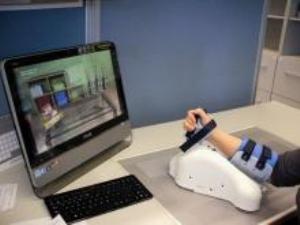TECNALIA has developed a new, advanced system that eases neuromuscular disability in stroke patients from the comfort of their homes. With the help of a portable robotic system plus a software platform with videogames, patients will be able to improve their arm movements.
 ArmAssist
ArmAssist
This will facilitate physicians to monitor the patients’ exercises via the quantitative results received from the video games. The project called ArmAssist is based at the La Fe Hospital in Valencia.
Instituto de Biomecánica de Valencia is studying the level of satisfaction among patients who have been hospitalized after a brain stroke. The ArmAssist will also be tested in Barcelona's Guttmann Institute.
The project‘s aim is to assess the viability of the system and the potential problems that can be encountered when taking the rehabilitation to the home. If it proves effective, then professional training can be given to both patients and therapists. For this project, the clinical protocol will be a non-randomised clinical experiment.
During the trials, the patients will use the ArmAssist system and then will be sent home with the system to continue the rehabilitation in their homes. A therapist would supervise their rehabilitation remotely.
The ArmAssist features a device that is linked to the user via an orthesis that captures and determines the movements of the elbow and shoulder. This portable base is linked to a PC, which in turn links the arm movements with the demand of the videogames designed ad hoc for treatment of the upper limbs.
The training games last longer. The aim is to encourage the patients to train their arms for a longer period of time. In addition, the video games provide memory games, puzzles and card solitaire games for mental stimulation.
The ArmAssist can be used by both chronic and acute phase stroke patients to train their upper limbs. It can also be used for other kinds of disorders.
The European Regional Development Fund (ERDF) and Science and Innovation Spanish Ministry have funded the project.